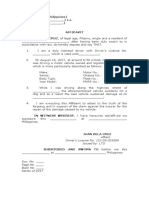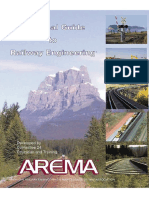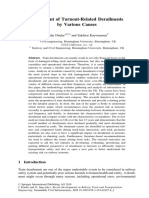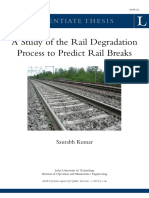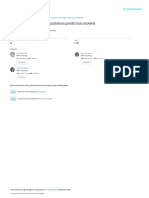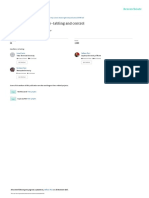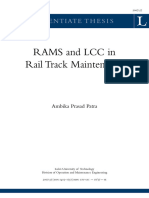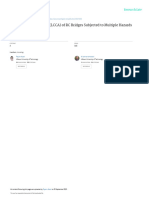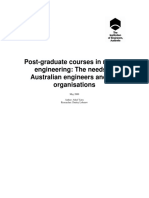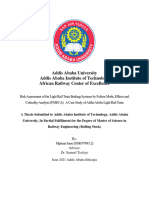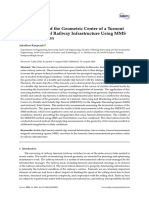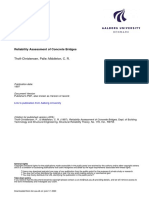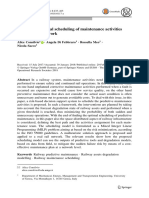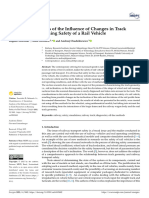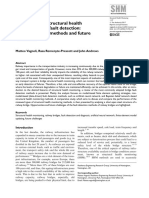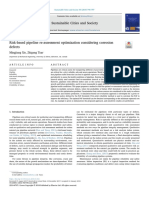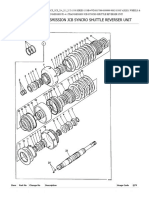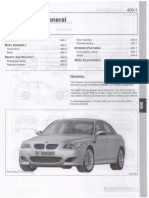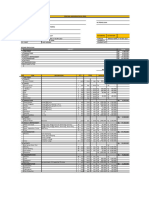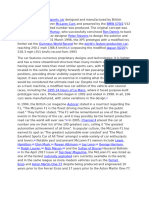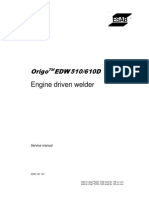Extended Abstract
Extended Abstract
Uploaded by
merlin_pasaribu08Copyright:
Available Formats
Extended Abstract
Extended Abstract
Uploaded by
merlin_pasaribu08Copyright
Available Formats
Share this document
Did you find this document useful?
Is this content inappropriate?
Copyright:
Available Formats
Extended Abstract
Extended Abstract
Uploaded by
merlin_pasaribu08Copyright:
Available Formats
See discussions, stats, and author profiles for this publication at: https://www.researchgate.
net/publication/313808568
A risk-based model for inspection and maintenance of railway rolling stock
Chapter · September 2016
DOI: 10.1201/9781315374987-175
CITATIONS READS
2 1,756
3 authors:
Fateme Dinmohammadi Babakalli M. Alkali
University College London Glasgow Caledonian University
27 PUBLICATIONS 475 CITATIONS 50 PUBLICATIONS 350 CITATIONS
SEE PROFILE SEE PROFILE
Mahmood Shafiee
University of Kent
139 PUBLICATIONS 2,424 CITATIONS
SEE PROFILE
Some of the authors of this publication are also working on these related projects:
UK Engineering and Physical Sciences Research Council (EPSRC) HOMEOffshore project (EPSRC Reference: EP/P009743/1). View project
Fault Diagnosis and Prognosis using Kernel Methods in Nonlinear Dynamic Processes View project
All content following this page was uploaded by Fateme Dinmohammadi on 15 October 2018.
The user has requested enhancement of the downloaded file.
A risk-based model for inspection and maintenance of railway rolling
stock
F. Dinmohammadi, B. Alkali
Department of Mechanical Engineering, School of Engineering and Built Environment, Glasgow Caledonian
University, United Kingdom
M. Shafiee
Cranfield University, College Road, Bedfordshire MK43 0AL, United Kingdom
ABSTRACT
Railway engineering is currently confronted with
various problems caused by premature failures of
railway assets that require costly and time-consuming
maintenance work. The railway assets in general are
categorized into two types: the rolling stock which
includes assets that can move on railroad and the
infrastructure which consists of fixed assets. Regular
inspection and maintenance of these two types of
assets is essential to ensure network availability and Fig. Rolling stock components
reliability, and passenger safety and comfort. To this For the purpose of clearly illustrating the proposed
aim, the decision-maker(s) must determine the most analysis approach, a case study of the Class 380
appropriate type, frequency and degree (quality) of train’s pantograph system operating in a Scottish
maintenance for railway assets such that the total cost company is provided. The performance the proposed
incurred over the life span is minimized and/or the risk-based inspection and maintenance method in
reliability of the rail network is maximized. An terms of life expectancy of rolling stock, whole life
effective approach to reduce railway maintenance cost and reliability is evaluated and compared with
costs is to prioritize and schedule the maintenance the currently used inspection methodologies such as
tasks on a criticality basis using the risk analysis run-to-failure, periodic renewal, and reliability
methods and tools. The risk-based inspection and centered inspection. The model presented in this
maintenance management of railway infrastructure paper not only provides the capability to assess the
has received a reasonable attention to date, however current maintenance practices within the railway
few studies have focused on rolling stock assets. transport industry but also helps the maintenance
The current study presents a modelling engineers to propose or initiate improvement actions
methodology aimed at planning the repair and when needed.
maintenance tasks of rolling stock components based
on risk measures. A quantitative model is developed
to evaluate the time-variant risks associated with REFERENCES
different types of failures in rolling stock assets. The
major failure modes of various components as well as Dinmohammadi F, Alkali B, Shafiee M, Berenguer C, Labib A
their common root causes are identified through an (2016) Failure mode, effects and criticality analysis of
railway rolling stock assets. In: Proceedings of the Third
importance analysis, and a probabilistic method is
International Conference on Railway Technology: Research,
proposed to estimate the likelihood of occurrence of Development and Maintenance, April 5–8, Cagliari, Italy.
failure. The consequences of failures are modelled Scarf, P., Alkali, B., Cavalcante, C., Berrade, M. D. and Tait, C.
using a discounted cost criterion that involves costs (2012). A study of the efficacy of inspection of railway
of inspection, maintenance and repair, the penalty rolling stock. In: the European Safety and Reliability
charges due to train delays or service interruption, and (ESREL) Conference, 335-340.
the costs of loss of reputation in relation with train Shafiee, M., Patriksson, M. and Chukova, S. (2016). An optimal
cancellations. The level of risk of failure over time age-usage maintenance strategy containing a failure penalty
for application to railway tracks. Proceedings of the
can then be used to prepare an appropriate inspection Institution of Mechanical Engineers, Part F: Journal of Rail
and maintenance programme. and Rapid Transit, 230(2), 407–417.
View publication stats
You might also like
- Affidavit of Own Damage To Vehicle - TemplateDocument1 pageAffidavit of Own Damage To Vehicle - TemplateChris Van86% (22)
- Practical Guide To Railway EngineeringDocument97 pagesPractical Guide To Railway EngineeringMyo Kyaw Kyaw75% (4)
- Dynamic Interaction of Train-Bridge Systems in High - Speed Railways - Theory and ApplicationsDocument590 pagesDynamic Interaction of Train-Bridge Systems in High - Speed Railways - Theory and ApplicationsEr.Praveen RajNo ratings yet
- Model: Frequency: Fuel Type: C1000 D6B 60 Diesel: Generator Set Data SheetDocument3 pagesModel: Frequency: Fuel Type: C1000 D6B 60 Diesel: Generator Set Data SheetIgorNo ratings yet
- Reference Values For Railway Sidings Track Geometry: SciencedirectDocument10 pagesReference Values For Railway Sidings Track Geometry: Sciencedirectjavier sotoNo ratings yet
- RamsDocument128 pagesRamsLuz Dary Carvajal Mendoza100% (2)
- Amm.393.453 WNDocument9 pagesAmm.393.453 WNm fathul alyNo ratings yet
- Assessment of Turnout-Related Derailments by Various CausesDocument13 pagesAssessment of Turnout-Related Derailments by Various CausesRubenNo ratings yet
- Reliability Engineering and System SafetyDocument13 pagesReliability Engineering and System Safetyskiu paket 31No ratings yet
- Selection and Ranking of Rail Vehicle Components For Optimal Lightweighting Using Composite MaterialsDocument14 pagesSelection and Ranking of Rail Vehicle Components For Optimal Lightweighting Using Composite MaterialsAwan AJaNo ratings yet
- Review of Train Wheel Fatigue LifeDocument15 pagesReview of Train Wheel Fatigue Lifeabdurhman suleimanNo ratings yet
- Dot 8995 DS1Document31 pagesDot 8995 DS1Bruno PerlesNo ratings yet
- Assessment of The Influence of Preventive MaintenanceDocument14 pagesAssessment of The Influence of Preventive MaintenancemaulanahafishNo ratings yet
- Atemplateforanundergngineeringcourse LAS190815Document10 pagesAtemplateforanundergngineeringcourse LAS190815Hazar JojoNo ratings yet
- 1 - MSC Thesis Proposal 2020-Ms-Rle-104 Kashif Ali 3Document10 pages1 - MSC Thesis Proposal 2020-Ms-Rle-104 Kashif Ali 3Ibrahim BajwaNo ratings yet
- Bai 2017Document12 pagesBai 2017RaghavendraSNo ratings yet
- G J E S R M: Lobal Ournal of Ngineering Cience and Esearch AnagementDocument5 pagesG J E S R M: Lobal Ournal of Ngineering Cience and Esearch AnagementJigar RavalNo ratings yet
- A Study of The Rail DegradationDocument93 pagesA Study of The Rail DegradationRenatoNo ratings yet
- Method For Effectiveness Assessment of Rolling Stock Investments Using LCC (Life Cycle Cost) AnalysisDocument9 pagesMethod For Effectiveness Assessment of Rolling Stock Investments Using LCC (Life Cycle Cost) AnalysisGAUTAM DUANo ratings yet
- Prediction of Wheel WearDocument20 pagesPrediction of Wheel Wearbenssj100% (1)
- Are View of Railtrack Degradation Prediction ModelsDocument17 pagesAre View of Railtrack Degradation Prediction ModelsRaghavendraSNo ratings yet
- Railway OperationsDocument18 pagesRailway OperationsdumitruusNo ratings yet
- Tesis - RAMS and LCC in Rail Track Maintenance, A.P. Patra, 2007Document107 pagesTesis - RAMS and LCC in Rail Track Maintenance, A.P. Patra, 2007Prabawa MalangkuceswaraNo ratings yet
- Modelling Rail Track Deterioration and Maintenance Current Practices and Future NeedsDocument19 pagesModelling Rail Track Deterioration and Maintenance Current Practices and Future Needsala younesNo ratings yet
- Full Text 03Document70 pagesFull Text 03Gaurav MandotNo ratings yet
- 26-Life-Cycle Cost Analysis of Bridge Deck Maintenance Under Traffic LoadingDocument36 pages26-Life-Cycle Cost Analysis of Bridge Deck Maintenance Under Traffic LoadingkevinNo ratings yet
- ch05Document18 pagesch05BabulalSahuNo ratings yet
- Numerical Analysis of Rail Structure Interaction and Resonance in Railway BridgesDocument11 pagesNumerical Analysis of Rail Structure Interaction and Resonance in Railway BridgesJEETENDRA PRAKASHNo ratings yet
- How Engineering Research Helps To Solve Societal ProblemsDocument7 pagesHow Engineering Research Helps To Solve Societal Problemssali powellNo ratings yet
- Mpiima IsaacDocument83 pagesMpiima IsaacengineeringtipsaNo ratings yet
- Sensors 20 04467 v4Document35 pagesSensors 20 04467 v4Miguel Ivan Acosta MondragonNo ratings yet
- Research On The Application of Fuzzy Bayesian NetwDocument19 pagesResearch On The Application of Fuzzy Bayesian NetwFatih AtaselimNo ratings yet
- RAMSDocument10 pagesRAMSmano9228No ratings yet
- Transportation Research Part C: Xiaojie Luan, Francesco Corman, Lingyun MengDocument27 pagesTransportation Research Part C: Xiaojie Luan, Francesco Corman, Lingyun MengImags GamiNo ratings yet
- Reliability Assessment of Concrete BridgesDocument29 pagesReliability Assessment of Concrete BridgesDiego RiveraNo ratings yet
- Traffic EngineeringDocument5 pagesTraffic EngineeringDheWi TobingNo ratings yet
- Preprints202109 0498 v1Document47 pagesPreprints202109 0498 v1Rajat RathoreNo ratings yet
- Journal Pre-Proofs: Computers & Industrial EngineeringDocument87 pagesJournal Pre-Proofs: Computers & Industrial EngineeringKHADIJA ABOUTAMMAMNo ratings yet
- Liden 2015 EWGT SurveyDocument11 pagesLiden 2015 EWGT SurveykengNo ratings yet
- Mamarikas PDFDocument111 pagesMamarikas PDFKrishan AcharyaNo ratings yet
- A Study On Wear Evaluation of Railway Wheels BasedDocument31 pagesA Study On Wear Evaluation of Railway Wheels BasedBiruk Yifru100% (1)
- 1 s2.0 S2192437620300339 MainDocument31 pages1 s2.0 S2192437620300339 MainYash SinghNo ratings yet
- Simulation Analysis of The Influence ofDocument19 pagesSimulation Analysis of The Influence ofsanjayrdsoNo ratings yet
- Researt Article by NaolkugDocument13 pagesReseart Article by NaolkugengineeringtipsaNo ratings yet
- Advanced Methodologies For The Assessment of The Fatigue Behaviour of Railway BridgesDocument340 pagesAdvanced Methodologies For The Assessment of The Fatigue Behaviour of Railway Bridgesunibas sismicaNo ratings yet
- Major Impactsof Learning Outcomesof Railway EngineeringDocument15 pagesMajor Impactsof Learning Outcomesof Railway Engineeringمحمد رجبNo ratings yet
- Railway Bridge Structural Health Monitoring and Fault DetectionDocument37 pagesRailway Bridge Structural Health Monitoring and Fault DetectionSaba AliyariNo ratings yet
- Sciencedirect: A Factor Analysis of Urban Railway Casualty Accidents and Establishment of Preventive Response SystemsDocument10 pagesSciencedirect: A Factor Analysis of Urban Railway Casualty Accidents and Establishment of Preventive Response SystemsOSAMANo ratings yet
- Mini Project Report Harsh Som JSRDocument23 pagesMini Project Report Harsh Som JSRharshsom.mba2325dNo ratings yet
- The Importance of Sleepers Spacing in RailwaysDocument15 pagesThe Importance of Sleepers Spacing in RailwaysPatrick Macedo100% (1)
- A Template For An Undergraduate Elective Final Year Lift (Elevator) Engineering CourseDocument10 pagesA Template For An Undergraduate Elective Final Year Lift (Elevator) Engineering CoursefreddyjoertyNo ratings yet
- MSC in Transportation EngineeringDocument8 pagesMSC in Transportation EngineeringKrishna Prasad PheluNo ratings yet
- Challenges of Bridge Maintenance Inspection: July 2016Document9 pagesChallenges of Bridge Maintenance Inspection: July 2016Sanket NaikNo ratings yet
- Reassesssment Inspection IliDocument12 pagesReassesssment Inspection IliDiego RiveraNo ratings yet
- FlyerDocument2 pagesFlyerrushikeshmagar540No ratings yet
- Research Topics-WPS OfficeDocument15 pagesResearch Topics-WPS OfficeengineeringtipsaNo ratings yet
- Journal of Rail Transport Planning & Management: Peri Smith, Arnab Majumdar, Washington Y. OchiengDocument9 pagesJournal of Rail Transport Planning & Management: Peri Smith, Arnab Majumdar, Washington Y. Ochiengfaisal_mqNo ratings yet
- Thesis BryantDocument231 pagesThesis BryantIonut IvanNo ratings yet
- Decision Support For Railway Track Facility Management Using OpenBIMDocument17 pagesDecision Support For Railway Track Facility Management Using OpenBIMdavid cerezalNo ratings yet
- Paper Proceeding ICAMIEDocument12 pagesPaper Proceeding ICAMIESulistiyoNo ratings yet
- Handbook of Optimization in the Railway IndustryFrom EverandHandbook of Optimization in the Railway IndustryRalf BorndörferNo ratings yet
- Risk Management in Life-Critical SystemsFrom EverandRisk Management in Life-Critical SystemsPatrick MillotNo ratings yet
- JCB EPC3Document3 pagesJCB EPC3chrideer100% (3)
- Body General E90Document8 pagesBody General E90jailemeilleurfrereaumondeNo ratings yet
- Scaffolding ChecklistDocument2 pagesScaffolding ChecklistAhmed Salah El DinNo ratings yet
- Company ProfileDocument12 pagesCompany ProfileAnand SNo ratings yet
- Non-Standard ApproachesDocument39 pagesNon-Standard Approachespatcharaphol charoenchonNo ratings yet
- امتحان 11 علمي شهر نهائي ف 1 ReadingDocument4 pagesامتحان 11 علمي شهر نهائي ف 1 ReadingSalam Hamad0% (1)
- SEMA Bulletin No 3 Rack ProtectionDocument3 pagesSEMA Bulletin No 3 Rack ProtectionAri WibisonoNo ratings yet
- Technical - Data - GX 127 LDocument4 pagesTechnical - Data - GX 127 LVictorPabloMenendezFoxNo ratings yet
- RAB-Gathering NestleDocument1 pageRAB-Gathering Nestledhi kaNo ratings yet
- 930 Parking Brake Handling Tool at Newmont - Penasquito Mine (RFQ082719-03) 1-24-2020 PDFDocument2 pages930 Parking Brake Handling Tool at Newmont - Penasquito Mine (RFQ082719-03) 1-24-2020 PDFJohn smithNo ratings yet
- Parata SamaDocument2 pagesParata Samas kNo ratings yet
- Mclaren F1Document1 pageMclaren F1ace zeroNo ratings yet
- 0 - PostEurop - 2010 - AESForum - AgendaDocument12 pages0 - PostEurop - 2010 - AESForum - Agendadjole7777No ratings yet
- Origo EDW 550D - Servicio - 0700161101C INDocument29 pagesOrigo EDW 550D - Servicio - 0700161101C INcarlosNo ratings yet
- Robber Barons and RebelsDocument1 pageRobber Barons and RebelsBMoNo ratings yet
- Petroleum Act 1934 - Rules 2002 PresentationDocument23 pagesPetroleum Act 1934 - Rules 2002 PresentationNilesh VetalNo ratings yet
- Capacity and Behaviour On One Way Cycle Tracks o 2016 Transportation ResearcDocument15 pagesCapacity and Behaviour On One Way Cycle Tracks o 2016 Transportation ResearcAllassane DOUMBIANo ratings yet
- Chapter-7 (Transportation Management)Document29 pagesChapter-7 (Transportation Management)mazharNo ratings yet
- Print: OEM Manufacturer Model OEMDocument3 pagesPrint: OEM Manufacturer Model OEMnilsonNo ratings yet
- Tank Design and Analysis For Ballast System in Ship: Corresponding EmailDocument4 pagesTank Design and Analysis For Ballast System in Ship: Corresponding Emailugik arfiandiNo ratings yet
- TA 7 - ĐỀ KIỂM TRA CUỐI KÌ 2 (2022-2023)Document5 pagesTA 7 - ĐỀ KIỂM TRA CUỐI KÌ 2 (2022-2023)tkhanhmy.eduNo ratings yet
- Interchange: Workbook Level 3Document7 pagesInterchange: Workbook Level 3Leila HannaneNo ratings yet
- Case Study Entitled TESLA MOTOR - Malyka TupazDocument4 pagesCase Study Entitled TESLA MOTOR - Malyka TupazMylen PelinNo ratings yet
- Invest Puerto Rico Presentation For AEPRDocument12 pagesInvest Puerto Rico Presentation For AEPRAEPR AEPRNo ratings yet
- AUTO TRANS - Removal & InstallationDocument42 pagesAUTO TRANS - Removal & InstallationIngenieria MultifuncionalNo ratings yet
- Part # Description Fitment PriceDocument7 pagesPart # Description Fitment Pricejeanett1683No ratings yet
- 7 Safety InstructionDocument57 pages7 Safety Instructionbelaye bekeleNo ratings yet
- Paes SummaryDocument16 pagesPaes SummaryKevin Lampaan100% (1)
